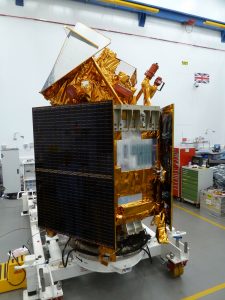Stevenage – Europe’s pollution monitoring satellite Sentinel-5 Precursor is ready to leave Airbus’ Stevenage site for launch on a Rokot rocket from Plesetsk Cosmodrome, Russia.
Sentinel-5 Precursor is part of the global monitoring programme “Copernicus”, a joint European Commission–ESA undertaking which aims to acquire continuous and accurate Earth observation data and provide services to improve the management of the environment, understand and mitigate the effects of climate change and ensure civil security.
Sentinel-5 Precursor will provide essential atmospheric chemistry data to the Copernicus programme before the Sentinel-5 instrument becomes operational in 2021 on the MetOpSecond Generation satellite.
Airbus was prime for Sentinel-5 Precursor, with three sites involved in development and manufacturing of the satellites and its components: Stevenage (UK – prime), Toulouse (France) and Friedrichshafen (Germany).
Colin Paynter, Managing Director of Airbus Defence and Space in the UK said: “For Sentinel-5 Precursor we used the commercially successful AstroBus platform, enabling us to meet challenging delivery and cost efficiency targets. This mission will give Europe new way to measure global pollution levels in much greater detail.”
Sentinel-5 Precursor features the TROPOMI (TROPOspheric Monitoring Instrument) instrument, developed by Airbus DS Netherlands for the European Space Agency (ESA) and the Netherlands Space Office. TROPOMI will measure ozone, nitrogen dioxide, sulphur dioxide, methane and other atmospheric pollutants at a higher resolution than previous instruments. Having more accurate atmospheric data will enable improvedclimate models and pollutant tracking and forecasting. The MetOp Second Generation spacecraft will feature a different Sentinel 5 instrument.
Josef Aschbacher, Director of Earth Observation Programmes at ESA said: “Sentinel-5 Precursor will be the sixth Sentinel satellite launched as part of the Copernicus space component. It will monitor atmospheric chemistry, an important parameter for air quality and climate change studies. The contribution of the TROPOMI instrument by The Netherlands has been crucial for this ESA mission.”









